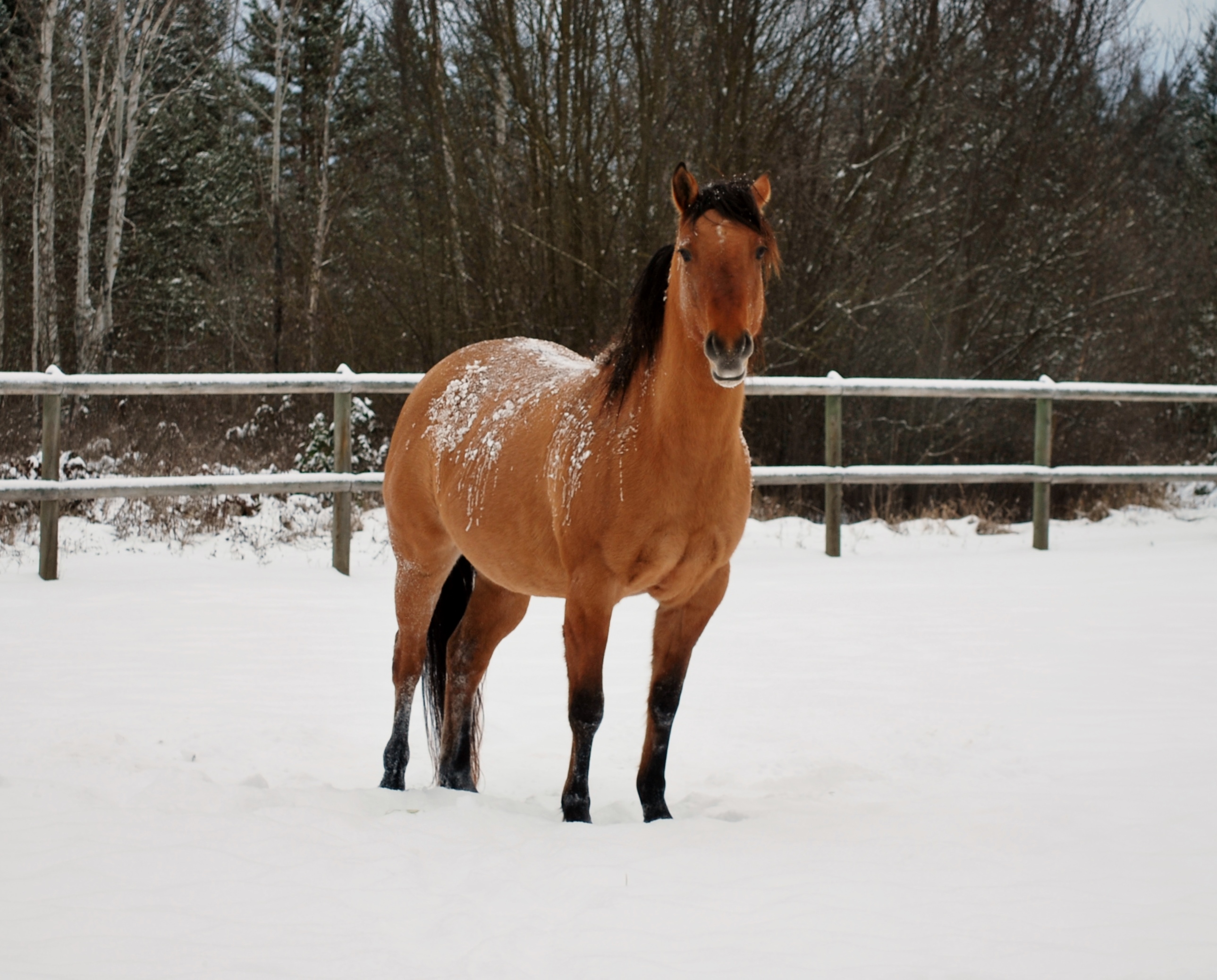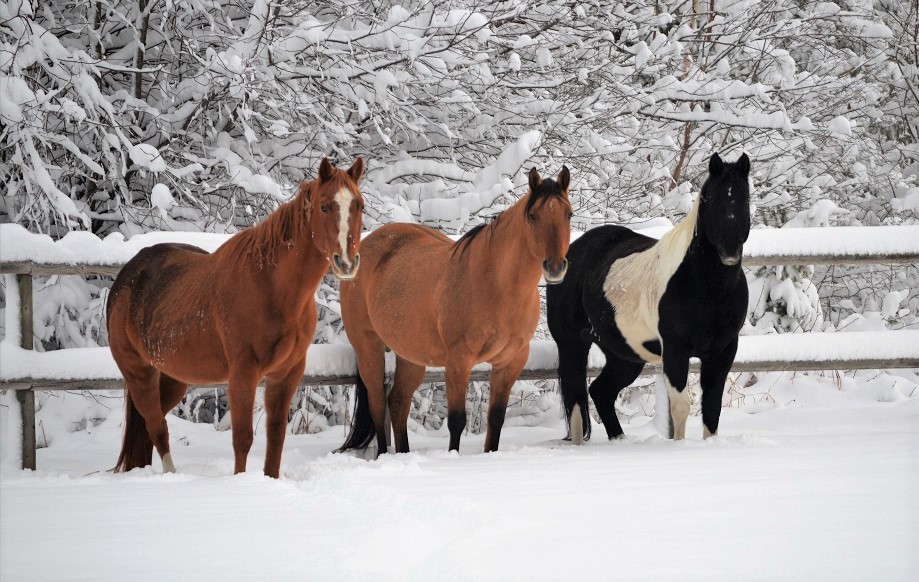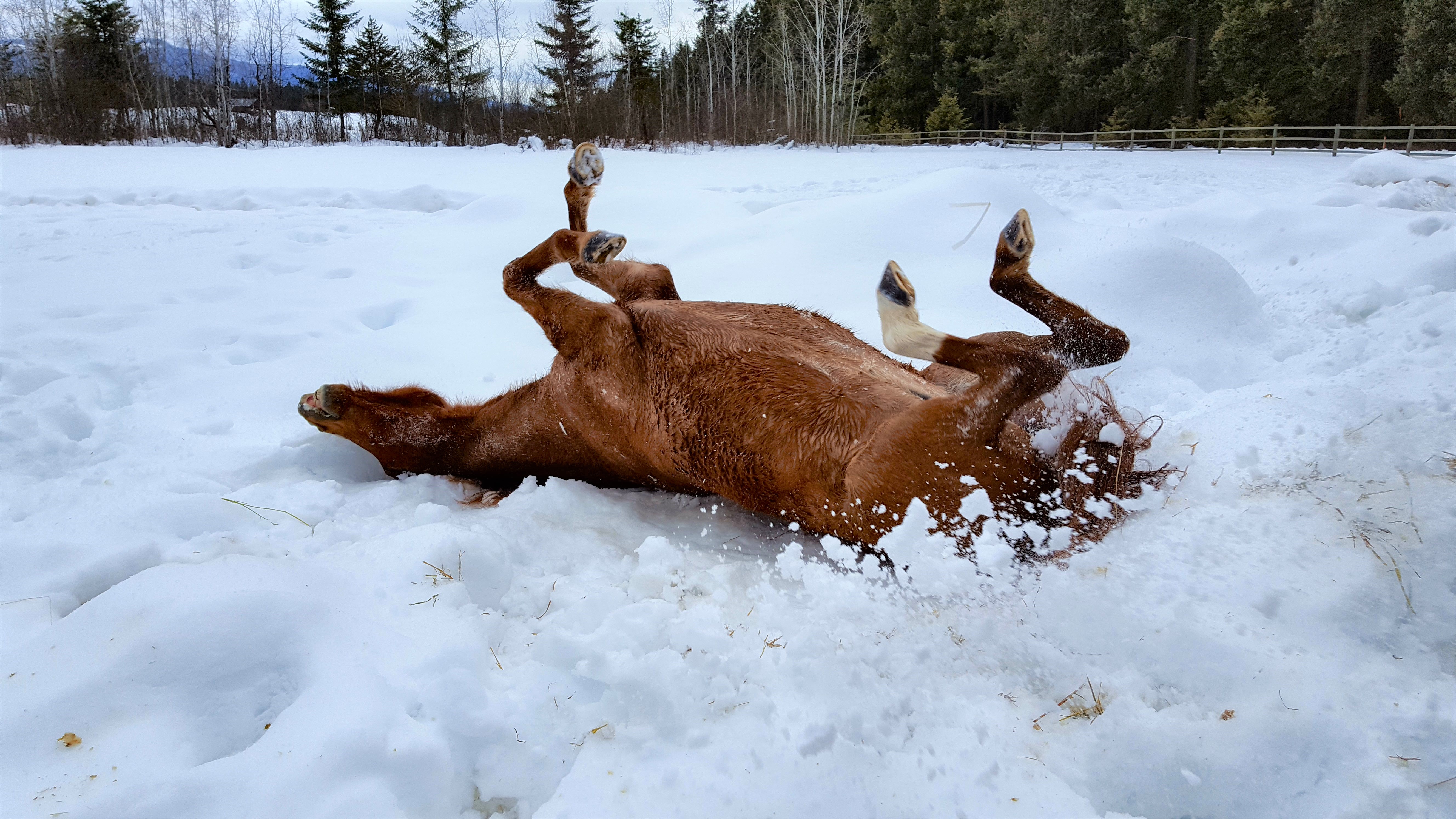To Blanket or Not to Blanket
Winter is upon us and can be a challenging time of year for the animal kingdom; including our domestic horses. Many people believe that their horses need to be blanketed in order to stay warm and/or to maintain weight. While others believe that horses are from the wild and that the natural horse doesn’t need any clothing in order to survive cold weather.
It turns out that the answer is not as simple as a yes or no, and that the decision needs to be based on each horse and their individual situation. Let’s first take a look at how horses normally retain body heat.
How Do Horses Naturally Stay Warm?
The first species of horses arose on several different continents, including Asia, Europe, and North America in a variety of different habitats with different climates. The exposure to both hot and cold climates required horses to develop unique methods of thermoregulation. These adaptations appear to have served them very well as to this day, whether they are wild or domestic, they are found to live in areas with all kinds of weather elements including wind, hot sun, pouring rain, deep snow, and temperatures which range from minus 50C to over 45C degrees.
There Are Three Primary Ways In Which Horses Stay Warm In Cold Weather
1. Skin
In large animals such as horses, the skin is very thick, in fact it may be a total of 12-24% of their entire body weight! The epidermis is the outer layer of the skin and acts as a barrier to both foreign substances and toxins. It also prevents heat loss, and protects from heat and cold. Horses also have a layer of sub-cutaneous fat under their skin which is an effective insulator and has three times more insulating capabilities than other tissues. This is why underweight horses are more at risk for cold-related problems. However, horses with a less thick fat layer will grow a longer hair coat than horses with more fat.
In general, horses have a greater ratio of surface area to body weight which helps to conserve heat as well. But smaller breeds with stocky builds grow thicker hair coats because they have more relative surface area from where to lose heat from. Think Shetland ponies or Fjords who grow very thick and heavy hair coats.
Horses may also shiver by contracting muscles to stimulate metabolism which breaks down ATP in the muscles resulting in more heat production. Shivering is usually only seen in response to sudden cold weather, or prolonged exposure to cold wet weather.
2. Hair Coat
A horse’s hair coat is an amazing thermoregulator. Hair coats are insulators which change thickness twice per year as they adjust to current temperatures by growing hair in the winter and shedding it out again in the summer. Colder climates produce thicker and longer coats, while warmer climates result in increased hair loss.
Hair coat changes react to sensors in the horse’s skin which are activated by changes in the hours of daylight. Amazingly, their hair begins to grow longer, albeit slowly, right after the summer solstice when days start getting shorter. And then hair loss begins again slowly, after the winter solstice when days start getting longer. A lot of us in the northern climates see a significant loss of guard hairs by the end of February.
Horses also have a mechanism called piloerection. Erector muscles in the hair follicles can raise or lower the hair coat which increases or decreases the thickness of the insulation layer. When the hair coat stands on end it increases the space between the hairs allowing an increase of air flow to the skin which then traps the body heat and creates a layer of insulating heat. This is what is happening when you see the raising or bristling of the hair in cold weather. Piloerection can increase the coat depth to anywhere from 10-30% in mature horses. But, in horses covered in rain or wet snow their piloerection ability drops, allowing the water to reach the skin which cools them off.
A horse’s hair coat is also covered in natural oils which helps to repel rain and melting snow keeping the deeper hair coat dry.
3. Arteries
Arteries either dilate or constrict depending on how much heat is required. This regulates the amount of blood flow to the skin. A large amount of blood flow during dilation will release heat and lower internal body temperature when it returns to the interior of the body. If the blood is not able to release enough heat, the sweat glands will secrete warm fluids. When arteries constrict the blood flow is reduced which will then conserve heat and prevent internal heat loss.

How to Keep Your Horses Warm (With or Without Blankets)
1. Provide Forage 24/7
A horse generates body heat by digesting food and fermenting fibre. Fermentation in the hindgut creates internal heat to help keep the body warm from within. Therefore, horses must have ample amounts of hay forage to stay warm in cold weather. High fibre foods such as beet pulp and various types of bran are also helpful.
2. Weight Maintenance
It is estimated that for each degree that the temperature drops below 0C degrees your horse needs an extra 1% increase in feed. Otherwise, s/he will lose weight due to the increased energy required to keep warm. And if a horse is being exercised in cold weather, they will lose weight very quickly if they don’t eat more than usual.
3. Water
Ensure that your horse has unfrozen water available that is warm enough to be palatable. Soaked beet pulp is also a good source of hydration.
Dehydration puts your horse at risk for weight loss, heat loss from digestive problems, colic, muscle cramps, muscle fatigue, and loss of coordination. And dry, cold air increases water loss from the respiratory airways and the lungs.
4. Exercise with Caution
Body temperature increases during exercise because heat is created by the muscles which are producing energy. But exercising in the cold can affect their ability to stay warm.
Exercising in cold weather uses more energy, and glycogen (stored starch used for energy) is burned up 5 times faster in cold weather. This is why horses (and people) lose weight faster by exercising in the cold.
I notice with my own horses if the temperature is below about minus 20C they really slow down and don’t walk a lot. At first this surprised me because I had assumed that more exercise would help keep them warm, but they instinctively know that by moving slowly they are conserving heat. It appears to be a seasonal biorhythm which comes naturally to them since wild horses have been observed to do the same. By breathing less frequently, they will reduce the heat lost in expired breaths. And less movement reduces the need for extra food should that not be available to the horse, whether domestic or wild.
Moderate cold is not usually a problem for healthy horses, as they only breathe through the nose, so the inhaled air is warm and moist before reaching the lungs. Nevertheless, respiratory symptoms can be common during very cold spells for some horses because the airways narrow or constrict caused by breathing large volumes of cold, dry air. This dehydrates the airways, and so the respiratory system doesn’t maintain the normal warm temperatures as easily. Dehydrated airways can also cause induced asthma.
5. Grooming
If your horses don’t wear a blanket it is best to not brush your horses in the wintertime since excessive brushing can distribute or remove the protective oils interfering with their repellent properties. For the same reason mud and dirt and even snow (unless melting) should be left on since all of these act as insulators.
6. Provide shelter
Horses will naturally seek out shelter, if available, from the rain and wind or heavy snowfalls. This is important because wild horses can use the forests and the trees, so we need to provide our domestic horses with the same freedoms to maintain comfort. It is estimated that a shelter can prevent up to 20% of a horse’s heat loss.
Horses will also often choose to stand with their hindquarters to the wind with their heads low. This helps to protect their vulnerable areas: head, ears, eyes, underbelly, and sheaths. Horses that are feeling cold may huddle together with the herd, may be reluctant to move from a sheltered space, or may not want to leave the barn if they are inside.
But horses that live outside with shelter, and no barn time are better able to maintain their body heat than a horse that is kept in a warm barn overnight with a blanket on and then gets turned out for the day.

Which Horses Could Use a Blanket?
1. Lifestyle Considerations
If your horse is or has not been enjoying natural living conditions, then a blanket could be warranted. Horses that have been previously blanketed might not have grown a thick enough coat yet. Horses that have been under artificial lighting will have inferior coats, horses that have been clipped will definitely need blankets, and the haircoats on horses that have moved from a warm to cold climate will need time to adjust. Similarly, horses that travel to a warmer climate for a short time and then return home to the cold will also need time to adapt.
And horses that don’t have any shelter at all against the wind, rain, and snow should be moved or a shelter made available. Barring those measures, an unsheltered horse in cold or wet climates (and even warm ones) will need a blanket.
2. Breed Considerations
Breeds that are heavier, with thicker compact legs, and lots of fetlock feathers have thicker skin and more fat. This would include the drafts, Warmbloods, Fjords, Icelandics, and some ponies who are more adapted to cold weather climates.
Horses with lighter bones, longer legs, leaner muscles, or silky hair coats have thinner skin and sometimes blood vessels that are visible. Thus, thoroughbreds and Arabs for example are better suited to warmer climates and may feel the cold more easily. Nevertheless, even lean horses know how to thermoregulate and with enough food, water, and shelter healthy light-breed horses will most likely not need blanketing.
3. Health Considerations
Senior horses with low metabolism may need help retaining heat in the cold weather since they are not as efficient as regulating their temperature as younger horses.
Underweight horses will need help since they don’t have less insulation.
Horses with chronic health problems and/or poor immunity may need extra warmth until they are feeling better.
Horses who have not or cannot grow a thick enough coat should be blanketed in cold climates.
Horses enduring chronic stress are less capable of retaining body heat since stress hormones interfere with the natural thermoregulatory mechanisms. Stabling, boredom, lack of freedom, lack of friendship, excessive training or exercise programs, and infrequent feedings of forage are all risk factors.
Responsibilities to the Blanketed Horse
Once a horse wears a blanket, we are obligated to pay attention to a number of things.
1.Blankets must be removed on a regular basis for various reasons.
a.To check for body temperature and the suitability of the blanket relative to the climate. And to ensure that they are not wet underneath which could chill them or cause rain rot. Make sure that their blankets are waterproof and/or insulated adequately as needed. Blankets must also be removed or replaced on warmer days. How many times have we seen horses wearing thick blankets on a too warm day? How uncomfortable this must be. Excess heat also interferes with metabolism so don’t let your blanketed horses sweat.
b.To check for weight loss and/or skin problems that may have developed from getting too warm and/or not being exposed to fresh air. Horses can develop blanket rubs, skin infections, or rashes.
c.To let them roll in the dirt, and the mud, and snow. This is how horses clean and massage themselves and ground themselves to the Earth.
2.If horses wear blankets and spend too much time in the barn their thermoregulatory mechanisms are less efficient from under-use. So, if these horses are suddenly exposed to very cold temperatures, it could not only result in an inability to stay warm but may also compromise the immune system and overall metabolism.
3.Keep in mind that blankets of all kinds do flatten the hair coat preventing piloerection and interfering with the insulating layer. Blankets also inhibit hair growth so transitioning from a blanket to no blanket should be done gradually according to the weather.
Conclusion
Consider your horse’s situation carefully as to whether or not they need a blanket. Horses that are acclimatized to their particular area, have access to shelter, have a good winter coat, have 24/7 forage, are not underweight, and have low stress levels are unlikely to need a blanket. I have a blanket here ready for my 25-year-old this winter but thus far she is showing no physical signs of needing help to keep warm. And surprisingly she makes very little use of the shelters, less than the younger horses, unless it is really raining or snowing hard.
Each horse is an individual however, so the choice is up to your horse; let them guide you so that you can make the best decision for them.



